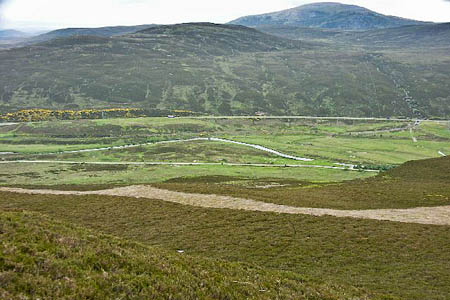The head of the Ramblers in Scotland has challenged the country’s First Minister to take a hike.
Convener Dennis Canavan called on Alex Salmond to join him on a historic walking route that is, he said, threatened by a ‘modern day Berlin Wall splitting the Highlands in half’.
The move by the Ramblers’ chief came as controversy grew over a decision to bar walkers, cyclists and horse riders from using a section of the old General Wade’s military road where it crosses the A9 near Newtonmore.
The section of the road is due to be turned into dual carriageway but Transport Scotland has refused to build a crossing and is putting up steel barriers at the site. Campaigners said the transport department risks having blood on its hands if someone is killed trying to cross the new dual carriageway.
And protests have been threatened which would block the road, which is the main route through the Highlands, linking Perth and Inverness.
A Sunday Herald piece today by Rob Edwards reported that a ‘summer of protest’ would be launched on 20 April. David Morris, director of Ramblers Scotland, said: “If ministers fail to solve this problem, we expect to exercise to our right to use the Wade road every week through the summer. It is likely to lead to far longer traffic hold-ups than the 10 minutes planned for 20 April.”
Mr Canavan has invited First Minister Alex Salmond to walk the route with him to see the problem at first hand. He said: “I expect the First Minister to seize the opportunity for a walk with us. His mother was a Ramblers stalwart, a founder member of our Linlithgow group.
“Sadly, I fear that she and many of her generation of ramblers would be turning in their graves if they could see today what Transport Scotland is doing to General Wade’s military road and our dearly held rights of public access.
“At Crubenmore, where they are extending the existing dual carriageway two miles further north, Transport Scotland has apparently decided to completely ignore the fact that General Wade’s military road crosses the existing A9, even though the importance of this route and its historical significance is explained in its own environmental impact assessment.
“But now that they are constructing the road and ignoring this commitment, building steel barriers across the right of way to prevent access over the road and refusing to build any alternative, either an underpass or overbridge.
“To anyone who asks how do walkers, cyclists or horseriders follow the Wade’s Road across 30 yards of dual carriageway, the Transport Scotland answer is simple: you cannot. All who want to use the ancient route which links together path networks on either side of the newly dualled A9 are now expected to divert a total of eight miles down to Kingussie, to use the underpass by Ruthven Barracks, and back up the other side to Crubenmore.
“This is nonsense and demonstrates a contempt for rights of way common law and the requirements of Scotland’s land-reform legislation.”
Mr Canavan called for the personal intervention of the First Minister: “This needs to be sorted out at the highest level,” he added.
“I want the First Minister to join with me and our local Badenoch and Strathspey Group members for a short walk along General Wade’s road.
“He needs to work out for himself how to use this magnificent walking route to cross the A9 and then instruct Transport Scotland bosses that they must not ignore the needs of walkers, cyclists and horseriders.
“And I want to know how Alex Salmond will stop Transport Scotland repeating these errors as the rest of the A9 is dualled between Perth and Inverness. Scotland deserves better than having a modern day Berlin Wall splitting the Highlands in half.
“All this must be resolved before the Scottish Parliamentary term ends on 23 March.”
The Wade roads were built in the 18th century under the command of General, later Field Marshal, George Wade, in an attempt to improve military control of Scotland. They were part of a system that included the construction of roads, bridges and barracks and more than 400km of tracks and 40 bridges.
The roads linked garrisons at Ruthven, Fort William, Fort Augustus and Fort George.

John Manning
06 March 2011No way will Alex Salmond go for a walk, unless he can borrow Donald Trump's golf buggy!
Elizabeth
07 March 2011Agreed, he doesn't really care about the countryside, Scotland's biggest asset.